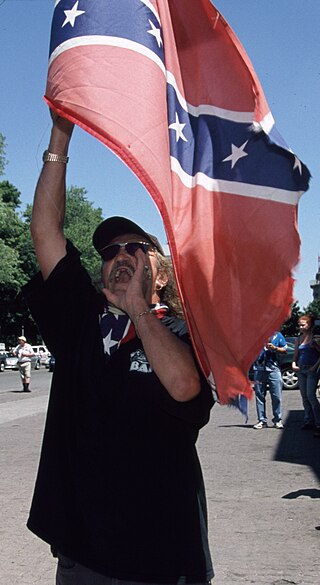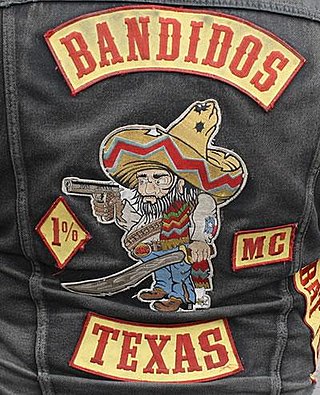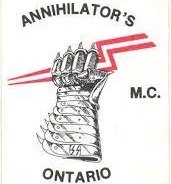Related Research Articles
The Shedden massacre involved the gang-related killing of eight men, whose bodies were found in a field five kilometres north of Shedden, a small village in the Canadian province of Ontario, on April 8, 2006. Four vehicles, with the bodies inside, were first discovered by a farmer. The day after the bodies were discovered, five people, including one member of the Bandidos motorcycle gang, were arrested for the murders, and three more people were arrested in June 2006. The Ontario Provincial Police (OPP) said the killings were an isolated event and there were no fears for the safety of local residents. The name Shedden massacre is a misnomer. The killings took place at a farm outside of Iona Station and Shedden was the hamlet closest to where the bodies were discovered in a farmer's field.
Iona Station is a hamlet located on the border of Dutton-Dunwich and Southwold townships, in Elgin County, Ontario, Canada.The "station" in the name was on the Canada Southern Railroad owned by the Michigan Central Railroad, later by the New York Central Railroad.

Wayne Earl Kellestine, better known as "Weiner" Kellestine, is a Canadian outlaw biker, gangster, and convicted murderer, currently serving a life sentence for first-degree murder for his killing six out of the eight victims of the Shedden massacre of 2006.
Michael James Sandham, better known as "Little Beaker", is a Canadian outlaw biker, criminal and convicted murderer currently serving a life sentence for his role in the Shedden massacre of 2006. Sandham, a former theology student, soldier, policeman and outlaw biker was described by journalist Jane Sims as "a control freak driven by bizarre ambition" to take over the outlaw biker scene in Manitoba.
Francesco "Cisco" Lenti is a Canadian outlaw biker and gangster, best known as the co-founder of the Loners Motorcycle Club.

The Loners Motorcycle Club (LMC) is an international outlaw motorcycle club founded in Woodbridge, Ontario, Canada in 1979. It has seventeen chapters in Canada, eleven chapters in Italy, eleven in the United States. They also possess several chapters in other countries across the world. The club was established by two prominent Italian-Canadian bikers, Frank Lenti and Gennaro Raso.

The Bandidos Motorcycle Club is classified as a motorcycle gang by law enforcement and intelligence agencies in numerous countries. While the club has denied being a criminal organization, Bandidos members have been convicted of partaking in criminal enterprises including theft, extortion, prostitution, drug trafficking and murder in various host nations.
Giovanni "John" Muscedere, also known as "Boxer", was a Canadian outlaw biker and gangster who served as the national president of the Bandidos Motorcycle Club in Canada from 2002 until his murder in 2006.

The Annihilators Motorcycle Club was a Canadian outlaw biker club and organized crime group of the 1980s and 1990s.
Dwight Mushey, better known as "Big Dee", is a Canadian outlaw biker, gangster and convicted murderer currently serving a life sentence for his role in the Shedden massacre of 2006.
Jamie Flanz, better known as "Goldberg", was a Canadian outlaw biker and gangster who was one of the victims of the Shedden massacre.
Paul Sinopoli was a Canadian outlaw biker and gangster, one of the victims of the Shedden massacre.
Luis Manny Raposo, better known as "Chopper" was a Canadian outlaw biker and gangster, one of the victims of the Shedden massacre of 2006.
Marcello Aravena is a Canadian mixed martial arts (MMA) fighter, outlaw biker and gangster serving a life sentence in prison following his conviction on seven counts of first-degree murder and one count of manslaughter for his role in the Shedden massacre of 2006.
George Kriarakis was a Canadian outlaw biker and gangster who served as the last national secretary of the Bandidos Motorcycle Club in Canada and was one of the victims of the Shedden massacre of 2006.
Francesco Salerno, better known as "Frank the Bammer" was a Canadian outlaw biker and gangster, who was one of the victims of the Shedden massacre.
George Jessome, better known as "Pony", was a Canadian outlaw biker and gangster, known as one of the victims of the Shedden massacre of 2006.
Michael Trotta, better known as "Little Mikey" was a Canadian outlaw biker and gangster, one of the victims of the Shedden massacre.
Brett Gardiner is a Canadian outlaw biker and gangster serving a life sentence for his role in the Shedden massacre of 2006.
M.H. is a Canadian former outlaw biker, gangster and police informer who played a key role in convicting the accused in the Shedden massacre trial of 2009. Due to a court order, M.H.'s name cannot be revealed and he is only known by his abbreviation.
References
- 1 2 Edwards 2010, pp. 216–217.
- 1 2 3 Edwards 2010, pp. 216.
- 1 2 Edwards 2010, pp. 217.
- 1 2 Langton 2010, p. 181.
- ↑ Edwards 2010, p. 217-218.
- ↑ Langton 2010, p. 184.
- ↑ Langton 2010, p. 184–185.
- ↑ Langton 2010, p. 188.
- ↑ Langton 2010, p. 189.
- ↑ Langton 2010, p. 190.
- ↑ Edwards 2010, p. 245.
- ↑ Edwards 2010, p. 244.
- ↑ Edwards 2010, p. 255.
- ↑ Langton 2010, p. 193.
- ↑ Edwards 2010, p. 260.
- ↑ Langton 2010, p. 195.
- ↑ Edwards 2010, p. 262-263.
- 1 2 Edwards 2010, p. 263.
- ↑ Edwards 2010, p. 264.
- ↑ Edwards 2010, p. 266.
- ↑ Langton 2010, p. 197.
- ↑ Edwards 2010, p. 297.
- 1 2 3 4 Edwards 2010, p. 375.
- 1 2 3 4 Edwards 2010, p. 420.
- ↑ Edwards 2010, p. 409.
- ↑ Edwards 2010, p. 428.
- ↑ Edwards 2010, p. 427.
- ↑ Edwards 2010, p. 427-428.
- ↑ "Six Bandidos guilty of first-degree murder". CBC News. Globe and Mail. 2009-10-29. Archived from the original on 2009-10-31. Retrieved 2009-10-29.
- ↑ Langton 2010, p. 203.